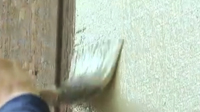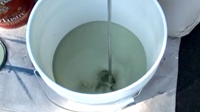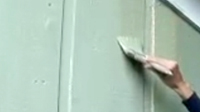You don't the permission to view this video
There’s perhaps no better and more affordable way to add interest to your home’s exterior than by giving it a fresh new coat of paint. Whether it’s time to try a new color, or apply a fresh coat of the same, an exterior painting project will help protect your home’s siding and trim from the elements. In this video, we’ll show you the basics of priming, caulking and painting your home’s exterior siding.
In our first video on "Exterior Paint Prep" we discussed the importance of properly preparing the surface before we start painting. Now comes the fun part ... seeing it all come together with a fresh coat of paint. And in our case, a fresh new color. But while you may have thought the prep stage was behind us, there are two more important prep steps before we begin applying paint. Priming and caulking.
In this second video in our "Exterior Painting" two-part series, we’ll discuss the importance of priming or spot priming our surface before we start painting. We’ll also show where you should caulk to keep the moisture out. Then, we’ll demonstrate some painting techniques used by the pros that will help you achieve the best finish possible.
So let’s get started.
Priming is one of the most important steps in exterior painting. There’s just no "substitute" for a good priming. In fact, that’s actually a good way to remember all the benefits of priming ... by remembering the word SUB, as in substitute. It’s an acronym for Sealing, Unifying and Bonding. First, a good primer coat Seals the surface that you’ve worked so hard to prepare. Next, it Unifies the substrate, including any bare wood, the previous coat of paint, as well as any patches in the substrate, such as wood filler, so the final coat will go on evenly. And finally, it Bonds the prepared substrate to the final coat, which ensures good adhesion. This bond between the undercoat and the finish coat is largely what’s responsible for protecting your house from damage that can be brought on by the elements, including rain, sun and wind.
Since our final coat will be light green in color, we’ve selected an all- purpose interior and exterior latex primer. We also had our local independent home improvement retailer tint it to a shade that’s very close to the color of our final coat. This will help us apply a consistent color, and might even allow us to get by with one finish coat instead of two. We’ll have to wait to determine that after we apply the first coat of paint.
Applying primer to the substrate is also largely a matter of preference. While many professional painters apply the primer coat with a sprayer to help speed the process along, we’re going brush it on, just like we will do for the finish coat. Applying our primer with a brush will help ensure total coverage of the primer, which again, might help us achieve one-coat paint coverage instead of two.
The brush we’ll use to apply our primer, as well as our paint, is this 3" synthetic bristle brush designed for applying latex paint on large surfaces. We could also use a 4" brush like this one, but it’s a little big for our taste. In the end, what size brush you choose is a matter of individual preference. The main considerations are that it has synthetic bristles and it’s comfortable in our hand.
For our soffits and trim, we’ll use this mini roller to avoid brush marks on this smooth surface. You can also use a brush ... it’s entirely up to you, and again, is largely a matter of preference.
Before we get started, we’ll strategically place tarps and mask off anything that might catch paint from above. Now it’s time to prime.
With a good, thick coat of primer covering our siding and trim, now it’s finally time to start brushing on that finish coat. But wait a minute. We’re not quite ready yet. There’s one last thing we need to do first. Caulking.
Caulking seals gaps that would otherwise allow water to penetrate the envelope of the house and get behind siding and trim. Here’s a perfect example of a crack that needs caulking. And here’s another one between trim board and soffit. See our Frequently Asked Questions for more information on what type of caulk to use.
Now, we’re finally ready to paint. We’ve selected a top-quality paint that will withstand the elements. And with all the work we’ve put into this project so far, we’re going to take our time and make sure we don’t cut any corners at this late stage in the game. You certainly don’t want to waste all your hard work with a sloppy paint job at this point.
So how will we know if our finish coat is properly adhering to the primed surface? There’s a simple test that will tell you. Before you begin painting, paint a small area that has been primed with your finish coat. Then let it dry overnight. When it’s dry, put some blue painters tape on it and let it sit for a few minutes. Peel it off and look to see if any paint comes off with it. If any paint peels off, that means you’ll need to sand and lightly rinse the surface before painting. Ours looks good, so we’re finally ready to start painting.
We’ll cut in trim boards just like we did in our video "Interior Priming and Painting." And remember, you shouldn’t wait any more than two weeks to apply the finish coat to primer, or the surface could oxidize, which could require another round of sanding. Also, it’s a good idea to plan your project when several nice days are forecast so rain or severe weather won’t ruin your finish.
There you have it. What a dramatic difference the new color makes. During the process we’ve also received lots of compliments from our neighbors, who almost seem as excited as we are. Not only have we improved our home’s curb appeal, but we’ve given our siding and trim a strong and durable finish that will stand up to the elements for years to come.
Steps
- 1.

Place a drop cloth below where you will be painting to protect surfaces, plants, etc.
- 2.

Apply the primer to the surface using either a paint brush, a roller or a sprayer. If using a latex primer, make sure it is between 50-degres and 90-degrees Fahrenheit. Allow the primer to dry.
- 3.

Use a quality exterior caulk to seal cracks and gaps in the siding, and between siding and trim.
- 4.

If you have more than one can of paint, combine them into one bucket for color consistency.
- 5.

Paint a small area and dry overnight. Test to see if the paint is adhering to the primer by placing a piece of painter’s tape on it. Peel it of after a few minutes. If paint comes off, you’ll need to sand and rinse the surface before painting.
- 6.

Apply one coat and let it dry overnight.
- 7.

Check the coat and apply a second coat if needed.



Comments (0)